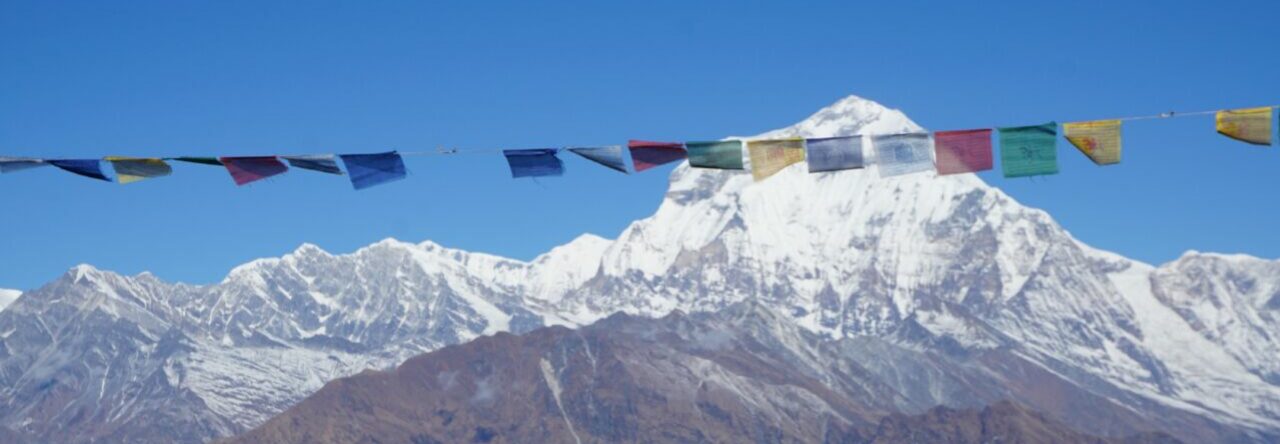The morning climb to Upper Melamchi was steep and difficult. Huge landslides had severely damaged the road, which was no longer accessible to vehicles, and had also taken out the foot trail. The people of Melamchi depended on the trails to get basic supplies and any food that they couldn’t grow themselves. This prompted a radical rebuilding of the trail by the U.N. organization for which the two Sherpas we met at dinner in Gangyul worked. Food for labor. And what an excellent job they had done! Sadly, the ancient chortens that marked the trail had become piles of stones. And the guest house where we stopped for tea was now a tin shack. You can see the photos from our 2015 trek to Upper Melamchi before the earthquake HERE .
Click on any photo to enlarge the picture and start the slideshow.
What a terrible sight greeted us when we arrived in Upper Melamchi! The destruction was even worse than we had imagined. The guest houses and chortens at the top of the trail and the beginning of the village were completely in ruins.
Everywhere people were rebuilding, many using salvaged wood from destroyed houses to make new homes, since money from the government and new supplies were almost non-existent. The hammering went on day in and day out.
We had hoped to stay at the Himalayan Lama Lodge, where we had stayed last year. The once two-story lodge was now a one-room tin and wood shack, and the damaged and unsafe dorms were replaced by a tin structure. Alas, when we arrived we couldn’t find the owners to inquire about staying there, so needed to look elsewhere.
The lodge was next to the once magnificent temple that shattered to the ground in minutes during the earthquake. Now it was a stunning backdrop to the local soccer games in the field behind.
Fortunately, we found Yangrima Lodge farther up the trail and settled into our room. This guest house was now just a simple structure of salvaged wood and tin, with a common room with a wood stove for warmth.
After our usual garlic soup for lunch, we sought out Kami Lama and his wife Jamayang, the owners of the destroyed Himalayan Lama Lodge and were delighted to see them again. It turned out that Kami is the brother of the Melamchi School’s principal and was happy to introduce us to the administrators and give us a tour.
We arrived just as a relay race was being completed, and preparations were in progress for the final ceremony before dismissal.
With Kami as our guide, we spent time visiting the classrooms and talking with the teachers and students. The school had been totally destroyed.
Two hundred children from several districts were being taught in temporary buildings. Each wooden/tin structure housed a grade and you could hear them reciting their lessons as you walked by. Here is a video that Cary took of our walk around the classrooms.
Shree Melamchi Ghyang Secondary School is a government school of very high standards and, with the dormitories destroyed, boarding students who lived far away now had to be housed in tents.
Meals served in the dining tent were cooked in a simple kitchen. Winter was coming and comforts were few. Sometimes it was so cold that the children were allowed to study in their tents wrapped in blankets or sleeping bags.

 Caritas is rebuilding the school and the director proudly showed us the plans posted on the wall of the administrative building. We met with several teachers and, again, shared Lynn Rubright’s gifts as well as money offerings from the South Whidbey Academy middle school children that we hoped would go to providing mats for the children. It was a very emotional moment, symbolized for me by the stark remains of a once-proud stupa.
Caritas is rebuilding the school and the director proudly showed us the plans posted on the wall of the administrative building. We met with several teachers and, again, shared Lynn Rubright’s gifts as well as money offerings from the South Whidbey Academy middle school children that we hoped would go to providing mats for the children. It was a very emotional moment, symbolized for me by the stark remains of a once-proud stupa.

Adam Frost, an American from Boise, Idaho, was teaching English in one of the classrooms. We had met him earlier when he and a Nepali friend were on their way to school. He has collected money to help in the rebuilding and also plans to form a trekking company when he returns home. His goal is to get young and old people more active in the outdoors.
We walked back through town surveying the damage and stopping to talk with residents who were working their small farms and building temporary homes for the winter. A plethora of gardens were growing among the ruins.
The devastation was everywhere but we were glad to see that some of the beautiful old stone walls were intact, or perhaps they had been rebuilt.
Our days in Upper Melamchi were packed with visits to various caves in the area. On the way to one of the Guru Rinpoche sites, we passed by a crack in the earth.
We spent four days in Melamchi and had time to get to know the gracious family who ran the guest house. My special friend was a twelve-year old boy, Chhewang Tamang, who helped with household duties and the care of his siblings when he wasn’t studying. As with most of the young people I talked with, he studied a wide variety of subjects and spoke several languages, including English.
Dinners took place in a warm dining room and were lively occasions. Buddhi, our guide, did his usual dancing, singing, and clowning, and the conversation was lively among various visitors and staff. Our main meal was, of course, dal bhat and garlic soup, sometimes supplemented with Tibetan mo-mos, a real treat. A bit of rakshi added to the hilarity!

During one meal we discussed the needs of the schools in the Langtang area where Brebin and Dawa, our porters, lived. You may remember that we visited this area four years ago. There are 500 people in the village and the school has been destroyed. These people are in the Tamang caste. The word “caste” is used in Nepal to denote one’s ethnic group, as we discussed at length over dinner. Many of you have probably heard of these groups: the Rai, Gurung, Bhotia, Thakali, Sherpa, Magar, Lama, Shresta, Tamang, Limbu, and Brahman (most of the government officials are in this caste). Often members of the groups can be identified by using these delineations as surnames.
Saying goodbye has always been hard for me, and this time it was especially poignant. Just before we left Upper Melamchi we spent more time with Kami Lama and his wife, Jamayang. This first photo below is our goodbye last year, in front of their lovely guesthouse. The next photo is our farewell in front of what they have managed to rebuild from its destruction.


 They honored me with the usual white kata, which I wore most of the way down on what became one of the most hazardous trails I’ve ever experienced.
They honored me with the usual white kata, which I wore most of the way down on what became one of the most hazardous trails I’ve ever experienced.
We now headed back to Thimbu, on our return to Kathmandu.

























































Ann Norris
Oh, my dear friend. Be careful on those trails. You are a brave and powerful woman to do the things you do. God bless you in your travels. Love ya!